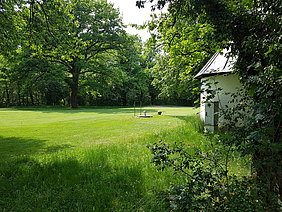In the pilot project, a novel approach was developed to systematically assess the possible risks to groundwater caused by the active substances in pesticides and their metabolites as a result of golf course maintenance. The aim was to establish a procedure, taking into account the requirements of both water supply and golfing. As a recommendation for golf course managers, principles of groundwater monitoring were also summarized to specifically and efficiently evaluate groundwater quality with regard to possible pesticide discharge via leachate from golf courses.
The use of pesticides on golf courses and the potentially adverse impact on waters, especially groundwater, has been discussed for many years. A major area of conflict for golf courses in water protection areas is how to balance golf sports and water protection. The German Golf Association (DGV) aims for golf to be played in accordance with statutes “taking into account the protection of nature and the environment” and has formulated specific guidelines, for example on integrated plant protection.
The “GREENwater” project
In addition to legal requirements, there is a common, ongoing interest in the golf and drinking water supply sectors to assess the risks of the active substances in pesticides and their metabolites to groundwater as a preventative measure and to prevent or minimise any future leaching of pesticides from golf courses into groundwater.
The DGV commissioned TZW to carry out the scientific research project “GREEN water – golf course maintenance and pesticide use: Decision-support models for the sustainable protection of groundwater."
Assessment scheme for pesticides
During the project, TZW developed an assessment scheme using readily available information to provide a systematic initial assessment of the possible risk of approved/authorised pesticide active substances and their metabolites leaching into groundwater as a result of golf course maintenance.
The artificial substrate composition and turf management of specific areas on golf courses like greens make it difficult to compare the site-specific situation with generic model assumptions made in the pesticide approval process as these generally relate to agricultural applications. More specific assessment criteria were therefore important and included the following:
- Substance properties relating to persistence and mobility
- Development of potentially relevant or non-relevant metabolites and their presence in groundwater or leachate
- Analytical determination of the target substances with regard to integrating the substances in routine monitoring.
The decision tree (flow chart) was tested with 50 selected substances (18 pesticide active substances and 32 associated metabolites) and was continually checked for plausibility and adjusted during the test runs.
As a result, the substances can be categorised according to their possible use (with monitoring as required). Knowledge gaps are identified systematically and selective research can be initiated for initial or reassessment.
As the systematic method takes into account the special boundary conditions on golf courses (like greens & tees), it is assumed that the results will be accepted in practice.
Recommendation for groundwater monitoring
Another result of the project is a recommendation on groundwater monitoring for golf course managers. This describes the principles, possibilities and strategies to efficiently and specifically monitor leachate, groundwater and raw water, in order to monitor the leaching of pesticides into the groundwater from golf courses at the respective location.
Participation strengthens practical application
Partners from water supply, approval authorities and golf were also involved in the project in addition to members of the German Golf Association working group “integrated plant protection”.
Their involvement made sure the approach was feasible in practice and that the results could be used as part of local collaboration between water supply companies, authorities and golf partners.

![[Translate to English:] Prüfstelle-Produktprüfung_Teststand Test centre and product testing](/fileadmin/_processed_/0/9/csm_TZW-Karlsruhe_Pruefung_Geraete-Teststand_377188946c.jpg)
























